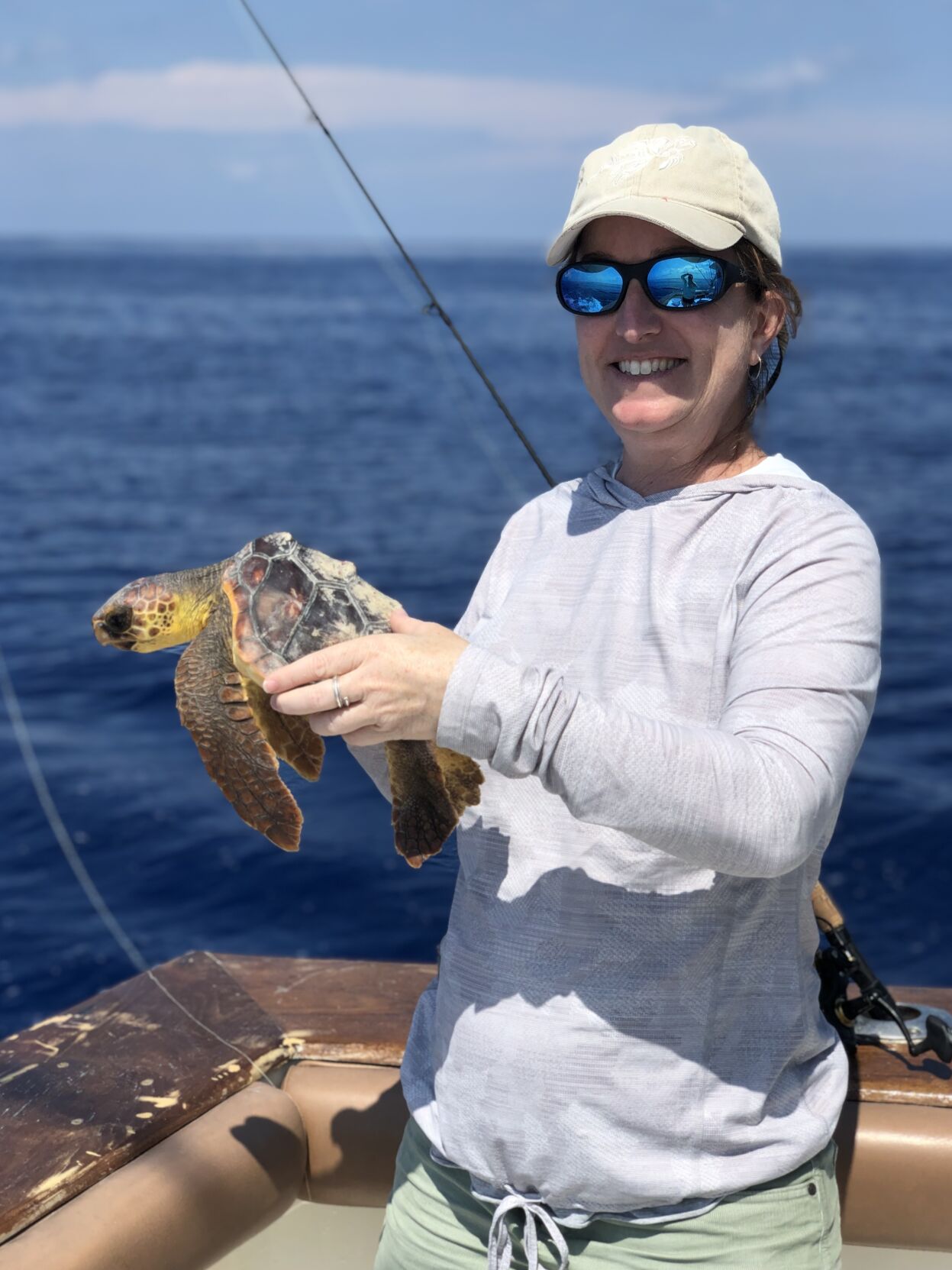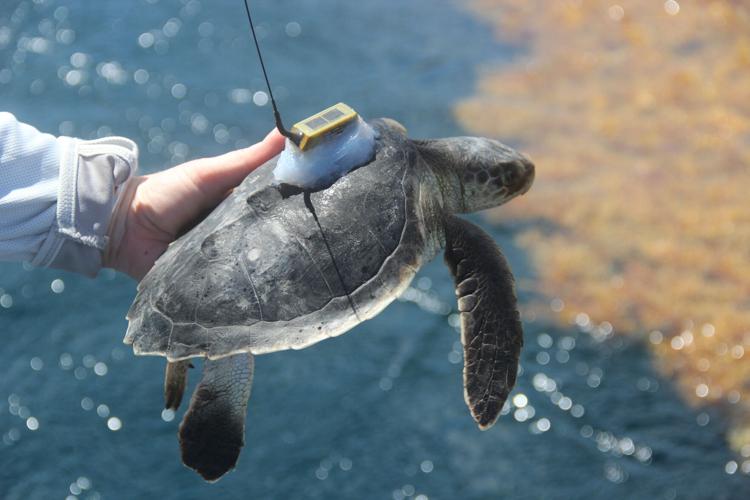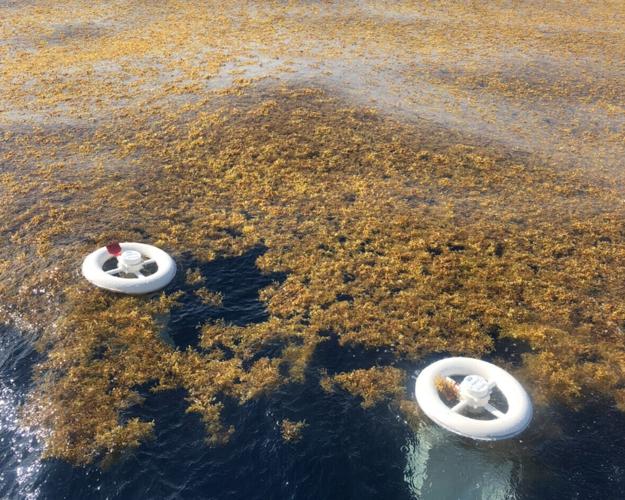
A UCF researcher holds a Kemp's ridley sea turtle before it is released after being tagged offshore of Venice, LA on June 4, 2014. Researchers used hair extension glue and animal safe aquarium silicone to adhere the tags onto the shell.
This photo was made with protected species permit NMFS 16377.
Researchers from UCF's Marine Turtle Research Group used satellite trackers to uncover new data released earlier this month regarding the behavior of young sea turtles during what is known as "the lost years."
"The lost years" term is used to describe turtles lives in between leaving a beach after hatching, to returning to shore as a juvenile. The new data suggests that previous hypotheses about the turtles’ behaviors and migration routes during this time may not have been as accurate as initially thought.
Dr. Kate Mansfield, research group director and UCF biology professor, along with her colleagues captured 131 juvenile sea turtles from 2011 to 2022.
After being captured, 114 of the turtles were tagged with small solar-powered satellite trackers using a combination of hair extension glue and clear aquarium silicone, which is an animal safe sealant found in aquariums. The team didn't have enough trackers to tag all of the turtles.
"[The trackers are] about the size of two small dice," Mansfield said. "They're only about 9 1/2 grams in weight, so we can glue them to the shells of the turtles."
The tags collected data on the turtles' locations, the ocean temperature and how well the tags were charging. After two to four months, the tags fell off as the turtles grew. The researchers also deployed "oceanographic surface drifters." These are devices that collected data on ocean currents and compared that with the data collected from the turtles' trackers.

Dr. Kate Mansfield holds a loggerhead sea turtle offshore of Destin, FL on May 13, 2022. Mansfield has been tagging and tracking juvenile sea turtles since 2011.
This photo was made with protected species permit NMFS 19508.
The data showed the distance between turtles and drifters exceeded the distance between individual drifters themselves. After 10-12 days, the distance between turtles and drifters was about 177 kilometers, compared to 39 kilometers for the distance between individual drifters.
"We were interested in looking at how much of where the turtles are going is their choice and how much is just them riding along on the currents," Dr. Katrina Phillips, a Ph.D. graduate of UCF's Integrative and Conservation Biology Program and lead author of the study said. "A lot of the drifters washed up on beaches, and none of the turtles did. They turned and went back out to deeper water again."
Mansfield said the group searched for turtles in Sargassum, which are large mats of brown algae that provide food and shelter where juvenile sea turtles are usually found.
Tiffany Dawson, doctoral candidate focusing on conservation and ecology, as well as a member of the research group, shared her experience assisting with the study.
"It's really an amazing experience to be offshore and kind of no land in sight," Dawson said. "When we do get them on the boat, it's a wonderful opportunity to learn about this life stage that we don't know a lot about."

Two oceanographic surface drifters are released into a Sargassum mat offshore of Destin, FL on June 11, 2021. These devices are used to determine whether the young turtles are swimming or drifting in the currents.
Data also showed that the turtles don't always stay as far offshore as initially thought. During the oceanic stage of their lives, the sea turtles are believed to be found only in water deeper than 200 meters, Phillips said.
"One of the reasons we know so little about this life stage is because they're way out there," Phillips said. "One of the surprising things we found is that they actually do come closer to shore and into shallower water than we thought."
These findings will play a huge role in future conservation efforts for these sea turtles, all of which are endangered. The study is suggesting shifting terminologies to behavioral definitions rather than place-based ones. The term "dispersal stage" is being recommended to describe the "lost years."
Mansfield said that pollution and the Deepwater Horizon oil spill have also played a significant role in their endangered status.
"What we've seen when we've been offshore is many of the little turtles that we collect, if we're lucky, they'll give us a poop sample, and a lot of them are pooping plastic," Mansfield said. "We see a lot of plastic and debris in the Sargassum mats. There were a lot of little turtles that were affected by that oil spill, which kind of prompted a lot of the work that I've been doing over the years."
Mansfield said Floridians can help with sea turtle conservation through the Sea Turtle License Plate Grant Program. Proceeds from plate sales go directly to the Florida Fish and Wildlife Conservation Commission's Marine Turtle Protection Program.
"If you're driving around and you see license plates with a little hatchling crawling across it, that supports research. They've supported a lot of the research here at UCF in my lab and my graduate students' research," Mansfield said. "That is one way that actually has a direct supportive pathway for sea turtle research and conservation in the state of Florida."















(0) comments
Welcome to the discussion.
Log In
Keep it Clean. Please avoid obscene, vulgar, lewd, racist or sexually-oriented language.
PLEASE TURN OFF YOUR CAPS LOCK.
Don't Threaten. Threats of harming another person will not be tolerated.
Be Truthful. Don't knowingly lie about anyone or anything.
Be Nice. No racism, sexism or any sort of -ism that is degrading to another person.
Be Proactive. Use the 'Report' link on each comment to let us know of abusive posts.
Share with Us. We'd love to hear eyewitness accounts, the history behind an article.